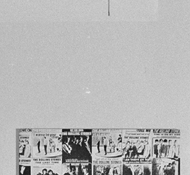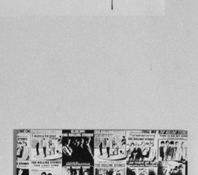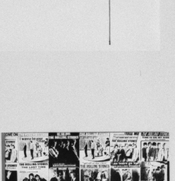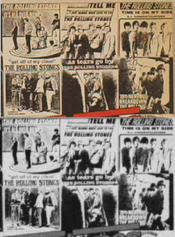Hi all -
I've mentioned some of this in a couple of other threads, but I figure it'd be worth its own post considering it doesn't totally fit into either. Hopefully it's not bothersome.
First things first: this isn't really a "fix my problem" post as much as it is me hoping someone can enlighten me about some fundamental developing mechanics. I've just started mixing my own chemicals, and I really don't know anything about what any of them are actually doing!
Anyway, I got my hands on some Kodak Imagelink, and after some ok-but-not-great efforts with HC-110 and Caffenol saw a bunch of shots from the somewhat legendary flickr member threepinner suggesting that H&W Control (recipe here) might be a good option. So of course I ordered some chemicals, because what could go wrong?
My first attempt (probably 3-4 minutes too long, considering I forgot that my water was at 22c) turned out rather heavily fogged. HW on the left, HC-110 in the middle, Caffenol on the right:
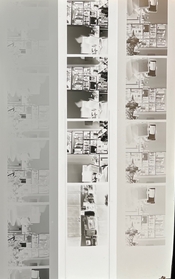
This seems to be in line with the experience of another poster but not with those of others elsewhere.
Today, I decided to try out the same developer with Copex Rapid. No fog at all, but I did get the same weird 'posterization' effect that I got with HR-Dev and the same film. Interestingly, though, the effect decreased as my EI increased; the frame shot at ISO 12 is rife with it but the one at 200 has none at all (and, with some PP, is pretty close to usable...cool!). Here's a crop from three frames, at ISO 50, 100, and 200:

The reason why I frame this question as being related to phenidone-based devs is that this writer had a similar issue when developing with POTA. I have no idea if it actually has anything to do with these two potentially unrelated issues!
Given the decreased effect with decreased exposure, the most obvious conclusion for me to jump to is that I overdeveloped the Copex, just like I'm sure I overdeveloped the Imagelink. It's also entirely possible that I didn't weigh out my chemicals perfectly, etc. But without further ado, here are my likely extremely stupid-sounding questions:
1. Is some aspect of the developer essentially finishing its job and then going to town on anything it can find? If so, what exactly is the process that's happening?
2. In the case of the Imagelink, and assuming the above is correct, is that base fog likely to be building throughout the process or is there a point at which it "kicks in?"
3. Possibly the stupidest-sounding question: could the fact that these were very short (6-7 frames) strips of film in full-strength 330ml-ish solutions have something to do with it?
Threepinner also has a recipe he's used that's just sulfite, carbonate, and metol. I'm going to give that a try later this week, but it seems like a shame to not use $30 worth of phenidone and hydroquinone (though I can't say I'm super excited by their toxicity).
But yeah, thanks for any answers you might offer. In the end I have enough film and chemistry to play around with times, etc., but I'd really love to know some of the science of what's actually going on here!
I've mentioned some of this in a couple of other threads, but I figure it'd be worth its own post considering it doesn't totally fit into either. Hopefully it's not bothersome.
First things first: this isn't really a "fix my problem" post as much as it is me hoping someone can enlighten me about some fundamental developing mechanics. I've just started mixing my own chemicals, and I really don't know anything about what any of them are actually doing!
Anyway, I got my hands on some Kodak Imagelink, and after some ok-but-not-great efforts with HC-110 and Caffenol saw a bunch of shots from the somewhat legendary flickr member threepinner suggesting that H&W Control (recipe here) might be a good option. So of course I ordered some chemicals, because what could go wrong?
My first attempt (probably 3-4 minutes too long, considering I forgot that my water was at 22c) turned out rather heavily fogged. HW on the left, HC-110 in the middle, Caffenol on the right:

This seems to be in line with the experience of another poster but not with those of others elsewhere.
Today, I decided to try out the same developer with Copex Rapid. No fog at all, but I did get the same weird 'posterization' effect that I got with HR-Dev and the same film. Interestingly, though, the effect decreased as my EI increased; the frame shot at ISO 12 is rife with it but the one at 200 has none at all (and, with some PP, is pretty close to usable...cool!). Here's a crop from three frames, at ISO 50, 100, and 200:

The reason why I frame this question as being related to phenidone-based devs is that this writer had a similar issue when developing with POTA. I have no idea if it actually has anything to do with these two potentially unrelated issues!
Given the decreased effect with decreased exposure, the most obvious conclusion for me to jump to is that I overdeveloped the Copex, just like I'm sure I overdeveloped the Imagelink. It's also entirely possible that I didn't weigh out my chemicals perfectly, etc. But without further ado, here are my likely extremely stupid-sounding questions:
1. Is some aspect of the developer essentially finishing its job and then going to town on anything it can find? If so, what exactly is the process that's happening?
2. In the case of the Imagelink, and assuming the above is correct, is that base fog likely to be building throughout the process or is there a point at which it "kicks in?"
3. Possibly the stupidest-sounding question: could the fact that these were very short (6-7 frames) strips of film in full-strength 330ml-ish solutions have something to do with it?
Threepinner also has a recipe he's used that's just sulfite, carbonate, and metol. I'm going to give that a try later this week, but it seems like a shame to not use $30 worth of phenidone and hydroquinone (though I can't say I'm super excited by their toxicity).
But yeah, thanks for any answers you might offer. In the end I have enough film and chemistry to play around with times, etc., but I'd really love to know some of the science of what's actually going on here!








